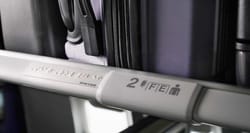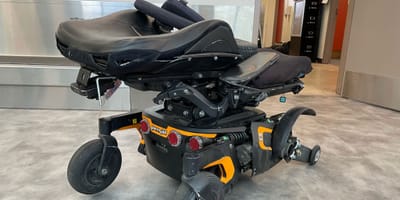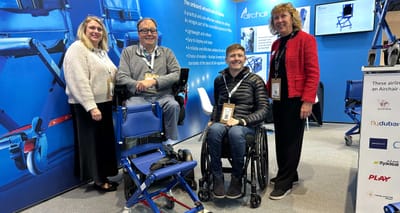Airlines damage wheelchairs and other forms of mobility equipment too frequently, often due to one of the Top 4 Reasons Wheelchairs are Damaged on Flights. Tools are available to reduce the risk of wheelchair damage and, while passengers eagerly await the first wheelchair space for airplanes to roll off the production line, airlines must adopt the strategies and tools outlined below.
Unit Load Device (Container)
Unit Load Devices (ULDs) are closed containers that are used to load luggage and other cargo on commercial and cargo aircraft. Various sizes of ULDs exist to fit different aircraft types, however each container is built to an exacting standard.


ULDs are used on wide-body aircraft including the Airbus A330 and A350, and Boeing 777 and 787. All manner of objects, luggage and cargo can be placed inside of a ULD, including the personal wheelchairs of airline passengers with disabilities. The photo above shows a Quantum power wheelchair tied down inside of a cargo container. The photo was taken at the international airport in Beijing, China, moments before the ULD was loaded on an American Airlines flight to the United States.
Closed container ULDs are compatible only with a single series of narrow-body aircraft, the Airbus A319, Airbus A320 and Airbus A321. These planes support the smallest ULD container, type LD3-45, which measures 45 inches tall. While many international carriers make heavy use of ULDs on the A320 family of aircraft, that is not the case in the United States. In Europe, if you’re flying on an Airbus A320, your wheelchair will almost certainly be carried inside of a container. Were U.S. carriers to do the same, the likelihood of wheelchair damage on thousands of domestic flights would decrease substantially. Cargo containers provide an important layer of protection for wheelchairs and U.S. carriers should not limit that protection only to long-haul flights on wide-body airplanes.
AmbuLift
The AmbuLift, also known as a High Loader or Passenger Boarding Lift, is a vehicle capable of transporting disabled passengers from the airport terminal to the door of the aircraft. While they are not in favor in the United States, nearly all European airports have employed one or more AmbuLift vehicles to expedite passenger boarding and assist in the retrieval and stowage of wheelchairs.

The photo above depicts a power wheelchair after it has been transferred from their AmbuLift vehicle to the belt loader for stowage in the aircraft’s cargo hold. The use of these vehicles to aid in wheelchair stowage assures that no ground staff member ever has to lift a passenger’s wheelchair, eliminating a major point of failure that would lead to high rates of wheelchair damage. AmbuLifts are also used to load wheelchairs into ULD containers on the wide-body and A320 family of aircraft that support them.
AmbuLifts can also be used to return wheelchairs directly to the door of the aircraft upon arrival, a service that is mandated in the United States by the Air Carrier Access Act.
Ramped baggage carts
Perhaps the simplest and most cost-effective method of eliminating the need for ground staff to lift a heavy wheelchair onto the belt loader is a ramped baggage cart.

The photo above, taken at the Orlando International Airport (MCO), contains one such baggage cart. With the ramp lowered, staff can push the wheelchair onto the baggage cart, then deploy the ramp into the belt loader — allowing for a barrier-free transfer of the wheelchair from the apron to the airplane’s cargo hold, no lifting required.
Height-adjustable wheelchair lift
The Mobility Chair Lift from Clyde Machines is a high-tech solution to the same problem — when ramp staff are forced to lift a heavy wheelchair, they risk personal injury and damage to the mobility device. Eliminating those unnecessary risks is essential.
The video above showcases the Mobility Chair Lift in action, collecting the chair from the apron and raising it up to the belt loader. The yellow tray can be used to bring the chair directly to the cargo door for barrier-free entry (though it was surprisingly not used to its full capability in this instance). The lift can carry wheelchairs of up to 700 pounds (317.5 kg) and relies on a 12 volt Electric over Hydraulic lifting mechanism. The lift has an on board battery charger and solar panel, making it a sustainable device and a great investment for airlines.
Jet bridge with baggage/wheelchair lift
Once the wheelchair has been taken off the aircraft, the focus turns to reconnecting it with the customer as quickly and safely as possible. Many older airports have limited elevator access from the terminal building to the ramp, meaning staff may often have to push wheelchairs a long way to find an accessible access point.
Wheelchair lifts connected directly to the passenger boarding bridge or jetway can shorten the time it takes to return a wheelchair, saving valuable man hours, quickening the pace of aircraft turns, and improving the experience for disabled passengers. I first saw such a lift in 2019 at Boston Logan International Airport, and have since seen them installed at many airports around the country. By eliminating unnecessary touch points, and providing a method for returning wheelchairs directly to the jet bridge, airlines reduce the risk of damage that may occur when wheelchairs are pushed (or worse, driven) long distances through the airport and down the jetway.
Tarps
Rain, sleet, and snow can all have damaging effects on mobility devices — from soaking seat cushions to corroding or infiltrating electronic components such as joysticks, headlights, charging ports and hydraulic mechanisms.
While airlines cannot control the weather, they do have control over the degree to which wheelchairs and other forms of mobility equipment are exposed to the elements. A simple tarp, available for less than $10 from Amazon, can be draped over a wheelchair as it is transported and loaded onto the aircraft.
Tools are just one part of the puzzle
Through the regular use of the tools outlined in this article, a majority of wheelchair damage could be eliminated. However, the presence of these tools alone is not enough — they must be used, and used properly.

In my 2019 article, Everything You Need to Know About Wheelchair Handling at American Airlines in One Photo, I shared the image above — baggage handlers, lifting my 400-pound power wheelchair despite there being a ramped baggage cart directly behind them. Since then, American and other carriers have debuted new technology, including the Clyde Machines Mobility Chair Lift. Even now, with these advanced tools parked just feet away, I have still witnessed crew lifting my wheelchair! Speed kills, as the saying goes, and when American and other carriers cut corners to save a minute or two, your mobility and mine is placed at risk.
The ultimate solution, we know, is a wheelchair space in the aircraft cabin — it can’t come soon enough.















